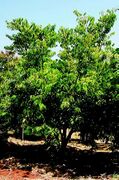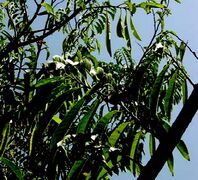Annona muricata: Difference between revisions
m clean up |
No edit summary |
||
| (2 intermediate revisions by one other user not shown) | |||
| Line 11: | Line 11: | ||
|english = | |english = | ||
|french = | |french = | ||
}}{{Box | |||
|title = Uses summary | |||
|color = lightgreen | |||
|text = | |||
}} | }} | ||
== Description == | |||
== | |||
<gallery mode="packed"> | <gallery mode="packed"> | ||
File:Annona muricata PROSEA linedrawing.tif|1, flowering branch; 2, branch with fruit (pseudocarp) (PROSEA) | File:Annona muricata PROSEA linedrawing.tif|1, flowering branch; 2, branch with fruit (pseudocarp) (PROSEA) | ||
| Line 30: | Line 27: | ||
File:Annona muricata drawing fruit Bekele-Tessemma Ethiopia.jpg|fruit | File:Annona muricata drawing fruit Bekele-Tessemma Ethiopia.jpg|fruit | ||
</gallery> | </gallery> | ||
== Popular names == | |||
{| class="wikitable" style="width:100%;" | |||
|} | |||
== Classification == | == Classification == | ||
| Line 38: | Line 40: | ||
== Uses == | == Uses == | ||
{{Citation box | |||
|text=''Anona muricata'' Linn. COROSSOL. PRICKLY CUSTARD APPLE. SOURSOP. Tropical America. This tree grows wild in Barbados and Jamaica but in Surinam has only escaped from gardens. It is cultivated in the whole of Brazil, Peru and Mexico. In Jamaica, the fruit is sought after only by negroes. The plant has quite recently been carried to Sierra Leone <ref>Unger, F. ''U.S. Pat. Off. Rpt.'' 350. 1859.</ref>. It is not mentioned among the fruits of Florida by Atwood <ref>''U.S.D.A. Rpt.'' 144. 1867.</ref> in 1867 but is included in the American Pomological Society's list for 1879. The smell and taste of the fruit, flowers and whole plant resemble much those of the black currant. The pulp of the fruit, says Lunan <ref>Lunan, J. ''Hort. Jam.'' 2:180. 1814.</ref>, is soft, white and of a sweetish taste, intermixed with oblong, dark colored seeds, and, according to Sloane, the unripe fruit dressed like turnips tastes like them. Morelet <ref>Morelet ''Trav. Cent. Amer.'' 21. 1871.</ref> says the rind of the fruit is thin, covering a white, unctuous pulp of a peculiar, but delicious, taste, which leaves on the palate a flavor of perfumed cream. It has a peculiarly agreeable flavor although coupled with a biting wild taste. Church <ref>Church, A. H. ''Food'' 203. 1887.</ref> says its leaves form corossol tea. | |||
<references/> | |||
|author =[[Anona (Sturtevant, 1919)#Anona muricata|Sturtevant, ''Notes on edible plants'', 1919]]. | |||
}} | |||
== References == | == References == | ||
Latest revision as of 16:39, 29 September 2025
Description
-
1, flowering branch; 2, branch with fruit (pseudocarp) (PROSEA)
-
habit
-
leaves
-
leaves and flower
-
fruit
-
fruit
Popular names
Classification
Cultivars
History
Uses
Anona muricata Linn. COROSSOL. PRICKLY CUSTARD APPLE. SOURSOP. Tropical America. This tree grows wild in Barbados and Jamaica but in Surinam has only escaped from gardens. It is cultivated in the whole of Brazil, Peru and Mexico. In Jamaica, the fruit is sought after only by negroes. The plant has quite recently been carried to Sierra Leone [1]. It is not mentioned among the fruits of Florida by Atwood [2] in 1867 but is included in the American Pomological Society's list for 1879. The smell and taste of the fruit, flowers and whole plant resemble much those of the black currant. The pulp of the fruit, says Lunan [3], is soft, white and of a sweetish taste, intermixed with oblong, dark colored seeds, and, according to Sloane, the unripe fruit dressed like turnips tastes like them. Morelet [4] says the rind of the fruit is thin, covering a white, unctuous pulp of a peculiar, but delicious, taste, which leaves on the palate a flavor of perfumed cream. It has a peculiarly agreeable flavor although coupled with a biting wild taste. Church [5] says its leaves form corossol tea.





